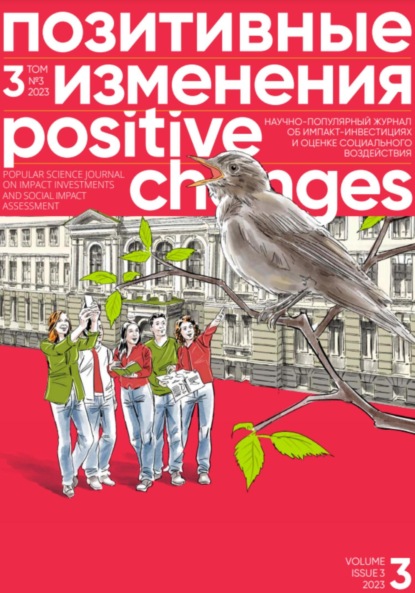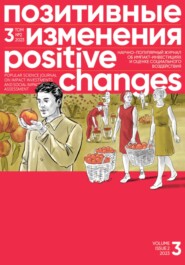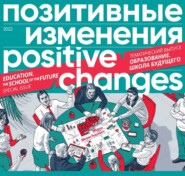По всем вопросам обращайтесь на: info@litportal.ru
(©) 2003-2024.
✖
Позитивные изменения. Том 3, № 3 (2023). Positive changes. Volume 3, Issue 3 (2023)
Настройки чтения
Размер шрифта
Высота строк
Поля
At this moment, the pivotal juncture for meaningful collaboration between universities and non-profit entities should not be overlooked, underscores Elena Isaeva. This is because higher education institutions embody the final bastion where an individual’s core values can be shaped. As such, it would be shortsighted to merely impart professional competencies to students, neglecting the cultivation of patriotism, civic responsibility, and broader philosophical perspectives.
“NGO leaders, being the most active proponents of the right cause, wield the potential to profoundly influence the development of civic character on an emotional level,” affirms Isaeva. “No one can resonate with the depths of the human soul quite like an NGO leader who herself is a mother to a differently-abled child. Her motivations transcend mere remuneration; her commitment arises from an unshakeable conviction that a different path in life is inconceivable, and she dedicates herself to alleviating the challenges faced by her child and those akin to him or her. Consequently, the integration of authentic, environment-born projects into the educational process is of paramount significance, as opposed to relying on contrived academic constructs.”
“We are currently at the stage of fostering a partnership culture between NGOs and universities. The data from the Presidential Grants Fund substantiates a burgeoning landscape where thousands of projects feature universities collaborating with NGOs,” remarks Artem Shadrin, Director of the Institute of Socio-Economic Design at the National Research University Higher School of Economics.
The scope of collaboration between universities and NGOs is extensive, spanning:
• The inclusion of nonprofits in the development and execution of educational programs: teaching, internships, practical experiences, and the establishment of collaborative structural units resembling foundational departments;
• The implementation of joint volunteer initiatives, involving not just students but also university staff;
• The orchestration of analytical research and the assessment of socio-economic outcomes for NGOs by universities;
• Collaboration in the execution of supplementary professional education programs and online courses;
• Allocation of dedicated spaces;
• Joint participation in formulating strategic developmental blueprints for territories, for instance, within the framework of “boiling point” initiatives, and much more.
PREREQUISITES FOR EFFECTIVE IMPLEMENTATION
In Artem Metelev’s perspective, the success of the “Service Learning” module hinges upon several factors:
1) The seamless amalgamation of theoretical education and hands-on societal involvement into a cohesive journey;
2) The cultivation and nourishment of partnerships between universities and NGOs;
3) The motivation of students to actively engage in resolving tangible social issues and challenges;
4) The formation of university-based teams comprising educators, methodologists, and proactive students, united in implementing the methodology;
5) The stimulation of regional NGOs to actively solicit their projects on the DOBRO.RF platform;
6) The expansion of students’ opportunities to partake in practice-oriented education and instilling in them a sense of solidarity towards the predicaments of others.
“Thus, after receiving knowledge in the classroom, students can leave the university grounds and venture forth to extend assistance, implement social initiatives, undergo internships, and actively contribute. In this dynamic, they effectively embody the role of both volunteers and aspirants seeking practical experience within their field of expertise.” – notes the expert.
Elena Isaeva postulates that one of the unique characteristics of implementing this technology in Russia is that not all universities have accumulated experience in collaborating with the non-profit sector. Additionally, a framework for rewarding staff members who are also members of NGOs is yet to be established. Thus, many universities will face initial challenges, necessitating them to identify suitable NGO partners, discern genuine endeavors from superficial ones, and ascertain whether it actually works. In this pursuit, reliance on regional resource centers and public chambers will be crucial, coupled with the establishment of agreements with those NGOs genuinely committed to channeling live, authentic projects for student involvement, as well as direct introduction of the service learning implementation supervisors with representatives of the regional non-profit sector.
“If service learning is being implemented for all student specializations, then the palette of NGOs involved in the learning process should be as broad as possible. That is why it is necessary to teach universities and NGOs to trust each other – to encourage a perspective that envisions universities as partners rather than mere talent incubators,” emphasizes Elena Isaeva.
This collaborative engagement between universities and the non-profit sector makes transformation inevitable, the expert says. It is paramount for both partners to recognize and embrace the benefits of it, approaching the partnership not as a mere obligation.
“If the implementation of service learning is set to continue for the long term (and we can anticipate that the technology will be piloted, refined, and eventually become commonplace), the process will undoubtedly come with its fair share of challenges. Therefore, it is crucial for the university to have a supportive partner – whether it be a public chamber or a resource center – that can explain the specifics of NGOs and guide their actions,” summarizes Elena Isaeva.
According to her, introducing service learning in freshman years is not advisable, given that students are still to acquire their professional skills. The primary objective of this technology is to bridge the gap between the acquired professional skills and real-life situations, which are presented to students for exploration under the guidance of a dedicated mentor. It is essential for the student to witness how their efforts contribute to improving people’s lives.
A TALE OF MUTUAL BENEFIT
All participants stand to gain from service learning: for students, this form of project-based engagement within their education motivates them to actively participate in the fabric of society. Not only does it help in building a positive image of the modern young citizen, but it also tangibly factors the results of such endeavors into their coursework and thesis projects. Universities, too, benefit from the implementation of this technology, as it promotes civic, personal, and professional development among students, enhances their academic performance, significantly elevates the social atmosphere within the institution, and transforms it into a vibrant hub within the local community, thereby improving its image. Social organizations, meanwhile, find that implementing service learning and collaborating with universities allows them to tap into a talent pool that universities build. This partnership offers resources ranging from essential research and tangible support to manpower.
It’s imperative, highlights Elena Isaeva, that the interaction strategy proves advantageous for both sides. “For the non-profit sector, this entails securing a large, reliable partner with a strong reputation and pursuing further joint projects in line with the university’s third mission. Universities, on the other hand, are keen on developing volunteering initiatives, enriching students’ extracurricular activities and the university’s event roster. This makes the university a consistent attendee at NGO fairs, civic forums, or hosting NGO events on campus – fostering meaningful involvement of both students and staff in socially significant activities and expanding their horizons.”
Artem Shadrin, Director of the Institute of Socio-Economic Design at the National Research University Higher School of Economics, perceives service learning as an intriguing narrative illustrating the real-world demand for applied project-based learning in implementing socially-focused projects. This approach empowers students to cultivate their hard and soft skills while motivating them with impactful, socially relevant outcomes stemming from their projects.[60 - Methodological recommendations for the implementation of the Service Learning module in higher education organizations in the Russian Federation. (2023). Retrieved from: https://nark.ru/upload/iblock/7bb/v3x8h3ar13°5umz1woovwwrgvdnhgyjf/Metod_rekomendatsii_Obuchenie-sluzheniem.pdf (accessed: 26.08.2023).] Non-profit organizations, on their part, derive substantial added value from partnerships with universities.
He emphasizes that the service learning format – where universities can genuinely support NGOs – facilitates networking, deepens relationships, and shapes a broader collaborative agenda. For universities adhering to the principles of project-based learning, it is imperative to offer engaging, motivating, and enriching tasks that foster professional growth. NGO leaders and staff members, frequently enthusiastic and charismatic individuals, provide an enriching experience for students, which is an added asset for universities, enabling them to attract top-notch candidates.
“In essence, this narrative centers on mutual benefit, making the task of nurturing such collaborations all the more relevant,” Shadrin elaborates.
“Interestingly, project-based learning has a strong history in our country’s engineering field. During the era of planned economies, engineering students would engage in real, functional projects as part of their education. Today, this approach to applied project-based learning is expanding into the realms of social sciences and humanities.”
Thus, over the past few years, more than a hundred universities across the country have adopted the format of legal clinics, where law students offer pro bono legal advice to citizens in need of legal guidance. At Saint Petersburg State University, besides legal clinics, there are 15 other clinics in various domains,[61 - Saint Petersburg State University. (2023). Practice in the clinic format at St. Petersburg State University. Retrieved from: https://spbu.ru/studentam/praktika-po-modeli-kliniki-v-spbgu (accessed: 25.08.2023).] such as social work, education, psychological counseling, all under the umbrella of the “clinical practice” framework.[62 - Lavrikova, M. Yu. & Rusakova, M. M. (2021). Modern labor market and education: a clinical approach as a response to the need for changes in training. Retrieved from: https://spbu.ru/sites/default/files/ kliniki_spbgu.pdf. (accessed: 25.08.2023).]
“In a similar vein, students from faculties such as economics and media communications can provide invaluable assistance to NGOs by crafting marketing and communication strategies. Students in IT can lend their expertise to configure information systems, while architecture, design, urban planning, and sociology students can contribute to the realization of land improvement projects. The possibilities are vast, and they extend to enlightenment initiatives for schoolchildren across the spectrum of natural sciences, humanities, engineering, and social studies. With numerous fields aligned to students’ professional pursuits, each offering a significant impact, service learning serves as a conduit for practically boundless self-realization within socially beneficial endeavors,” summarizes Artem Shadrin.
WORKING ON TOMORROW
The partitioning of service learning into a distinct domain and its systematic, deliberate integration into Russia’s educational landscape has become a necessity. This isn’t driven by fleeting trends or a momentary wave – it is an organic adaptation to an evolving world, where the consciousness of every individual holds newfound value. Much like the typewriter yielded to modern marvels like computers, smartphones, and the internet, envisioning a higher education institution untouched by educational technologies that pivot on humanism and align with contemporary values is becoming increasingly challenging. To be more precise, one definitely could imagine such an institution, but it would inevitably pale in comparison to its peers, those that grasp new currents and embed them in their curricula.
While ongoing debates continue to surface – should service learning be included into a core curriculum or remain elective? Should it be lifelong learning or not? Is it necessary to expose every student to this narrative? Can multidisciplinary pursuits harmonize within such pedagogy? Which thrives – collective collaboration or personalized approaches? Whose impetus should drive this initiative? and more – regardless of these unresolved questions, the wheels of progress are in motion, and they are spinning with vigor. As for what lies ahead (and service learning fundamentally revolves around forging pathways with the future), we will find out soon!
Экспертные статьи / Expert Publications
Совместный поиск ответов на общественный запрос: практики участия грантодающих фондов в реализации «третьей миссии» университетов
Все больше университетов осознают, что «третья миссия» – неотъемлемая часть высшей школы. Вузы стремятся активно взаимодействовать с обществом, становясь партнерами бизнеса, госструктур, локальных сообществ и других заинтересованных сторон. А благодаря поддержке грантодающих фондов университеты получают возможность воплощать свои идеи и проекты, способствуя прогрессу и укрепляя свою репутацию социально ответственных институтов. Рассказываем о том, как филантропические организации участвуют в формулировании и реализации университетами «третьей миссии» на примере Благотворительного фонда Владимира Потанина – одного из первых благо творительных фондов в России, поддерживающих и развивающих институт высшего образования.
Александра Авдеева
Менеджер проектов Благотворительного фонда Владимира Потанина
ГЛОБАЛЬНЫЙ ТРЕНД
Начать разговор о «третьей миссии» следует с происхождения термина. История этого понятия связана с эволюцией роли университетов в обществе и стремления построить более «социально ориентированный университет» (Shek & Hollister, 2017). Термин возник во второй половине XX века и был призван отразить расширение функций университетов за пределы образования и научного знания (Кудряшова & Сорокин, 2019). Классическим трудом, посвященным данной проблематике, считается «Методология третьей миссии университетов» М. Мархла и А. Паусиста, в котором «третья миссия» определяется как «совокупность специфических услуг, основанных на действиях и возможностях, служащих для блага общества» (Мархл & Паусист, 2013). На практике сегодня «третья миссия», как правило, связывается с такими аспектами деятельности университетов как технологический трансфер, взаимодействие с бизнесом, развитие и внедрение инноваций в социальной сфере, партнерство с местными сообществами и органами власти для достижения общественного блага (Кудряшова, Сорокин & Бугаенко, 2020).
В действительности единого общепринятого определения «третьей миссии» на сегодняшний день не сформулировано, что открывает широкие возможности для научной дискуссии (Кудряшова & Сорокин, 2020)[63 - Анализу понятия «третьей миссии» посвящена статья Е. В. Кудряшовой и С. Э. Сорокина «Третья миссия» университетов как предмет научного анализа», в которой, помимо историографического обзора, приведена библиография отечественных и зарубежных работ по этой теме.].
Поиск подходов к пониманию и реализации «третьей миссии» университетов – это глобальный тренд, но его локальные контексты в существенной степени обусловлены специфическими особенностями каждого отдельно взятого университета, влиянием государства на сферу образования, уровнем развития предпринимательства в стране и другими факторами (Балмасова, 2015).
Российские исследователи ввели термин «третья миссия» в научный оборот в 2010-х: различные определения термина, как и различные взгляды на эту концепцию, приводятся, например, в работах О. В. Перфильевой (2011), Н. А. Медушевского (2016), И. В. Головко (2018) и других авторов.
Сегодня можно констатировать, что дискуссия о «третьей миссии» в России вышла за пределы узкоспециального научного поля и приобрела характер широкого общественного обсуждения. О ней говорят сегодня все – от министров и ректоров крупных университетов до предпринимателей, журналистов, и, конечно, представителей третьего сектора экономики – руководителей и сотрудников некоммерческих организаций.
ТРЕТИЙ СЕКТОР КАК ВАЖНЫЙ УЧАСТНИК РЕАЛИЗАЦИИ «ТРЕТЬЕЙ МИССИИ»
Некоммерческие организации (НКО) – благотворительные фонды и общественные организации – важные участники дискурса о «третьей миссии» университетов: и вузы, и НКО вовлечены в решение острых социальных проблем современности (Медушевский, 2016). А значит, в целях достижения общественного блага сотрудничество НКО и университетов может быть взаимовыгодным и продуктивным, ведь что такое «третья миссия», как не совместный поиск ответов на актуальный общественный запрос?
Некоммерческие организации служат своеобразным связующим звеном между высшей школой и различными секторами общества. Совместные исследовательские проекты, образовательные и волонтерские программы, студенческие практики, публичные мероприятия – вот лишь немногие из форматов, которые могут совместно реализовываться вузами и НКО.














